Improved Predictability of Microstructure Evolution during Hot Deformation of Titanium Alloys
Abstract
:1. Introduction
2. Materials and Methods
3. Modeling Strategy
3.1. Microstructure Model
3.2. Constitutive Equations
3.3. Load Partitioning
- Ti-5553—the rotation and accommodation of plastic deformation in the α-particles up to a steady-state condition lead to the change from iso-power to iso-stress regimes;
- Ti-17—the process of dynamic α-globularization leads to a change from iso-strain to iso-stress regimes.
3.3.1. Overall Stress
3.3.2. Fraction of Material in Iso-Stress Regime
3.4. Dynamic α-Globularization
3.5. Rate Equations and Microstructure Evolution
3.5.1. Mobile Dislocation Density
- the developed model does not consider any effect of texture and change in the Taylor factor (M);
- the Burgers vector (b) is constant during deformation;
- the glide velocity is independent of strain if the plastic strain rate and temperature are kept constant.
3.5.2. Immobile Dislocation Density
- a term with a recovery coefficient (h2) to describe the consumption of immobile dislocations that occurs due to their rearrangement and annihilation [40] by DRV;
- a softening term to describe the consumption of immobile dislocations that are swept by the movement of HAGBs during cDRX.
3.5.3. Boundary Density and Misorientation Distribution
3.5.4. Wall Dislocation Density, Grain and Subgrain Size
4. Results and Discussion
4.1. Measured Microstructure
- in the platelets of the α-phase promote α/β interface migration and the progressive globularization of the α-phase;
- within the β-phase as the consequence of the progressive increase in boundary misorientation angle.
4.1.1. α-Phase
- Ti-5553 exhibits an initial globular α-phase microstructure (Figure 2a), and slightly elongated α-particles due to plastic deformation after hot deformation at 820 °C and 0.001 s−1; Figure 2b. Ti-17 has an initial lamellar α-phase; Figure 2c. The α-phase becomes partially dynamically globularized after hot deformation at 810 °C and 0.001 s−1; Figure 2d.
4.1.2. β-Phase
- Ti-5553: Figure 1a shows elongated β-grains perpendicular to the forging direction before deformation at 820 °C. LAGBs and HAGBs were formed in the β-phase after deformation at 820 °C and 0.001 s−1; Figure 3a. The dissolution of the α-phase beyond 920 °C and the higher HAGBs mobility promotes the formation of a fully recrystallized microstructure after annealing, Figure 1b;
- Figure 3b,d show larger recovered subgrains with very few newly formed HAGBs for the Ti-5553 and Ti-17 deformed in the β-domain.
4.2. Identification of the Restoration Phenomena
4.3. Flow Curves
4.4. Microstructure Evolution Predictions
4.4.1. α-Phase
4.4.2. β-Phase
4.5. “Model G”: Contributions to Deformation
4.6. “Model G”: Strain Rates
4.7. Predictions for Different Initial Microstructure
4.8. Model and Measurements
- Model assumptions: the mobile dislocation density is considered constant in “Model KM”, and no term to describe its influence on the cDRX is given. This issue is overcome in “Model G”, but with the assumption that the mobile dislocation is adjusted to yield a constant value once a maximum value is achieved. Additionally, its calculation is performed, assuming a constant thermal stress for a given temperature and strain rate. The limitations on the prediction of mobile dislocation density affect directly both the stress and microstructure evolutions. The effect of texture formation on the thermal stress, or the Taylor factor, is not considered, affecting the overall prediction of the stress evolution, and indirectly the microstructure evolution. Another limitation is the phenomenological description of the HAGB velocity and its power–law dependency uniquely via the strain rate (see Appendix G). This strongly affects the evolution of the boundary density and the average boundary misorientation. In the case of “Model G”, the dependence of the boundary evolution on the applied strain rate is greatly influenced by the phenomenological description of the (see Appendix A), as well as by the constant (see Appendix A).
- Measurements issues: the limited measurement area size impacts the statistical significance of the measured values. The large previous β-grain size limits the accuracy of the determination of the fraction of HAGBs, since more/less initial β-HAGBs can be considered depending on the measurement site. The formation of the substructure occurs heterogeneously within the β-grain since recovery occurs preferentially in the vicinity of the previous β-HAGBs [58]. Moreover, DRV and consequently cDRX occur differently in each grain, since the Schmid factor of each grain in a polycrystal is different. Thus, the limited measurement area size leads to local information on subgrain size and the fraction of HAGBs that is strongly influenced by the area wherein the EBSD measurement was performed.
5. Summary and Conclusions
- The mobile dislocation density can be estimated by “Model G” for any deformation condition, while it needs to be assumed for the “Model KM”;
- The kinetics of immobile dislocation density evolution depend on the kinetics subgrain size for “Model G”. “Model KM” predicts a fast increase in immobile dislocation density followed by saturation;
- The applied and plastic strain rate are considered the same for “Model KM”, and the calculations start at the yield point. The separation between elastic and plastic strains allows the modeling of the elastic part using “Model G”, as well as the interpretation of the kinetics of hardening and softening in the material;
- Both models predict the dynamic globularization of the α-phase for any initial thickness and aspect ratio, and its evolution is not only described in terms of the fraction of globularization but also the evolution of the microstructural features (thickness, width, the fraction of HAGBs within the α-phase);
- The load partition model describes the overall flow softening in the α+β-domain. The predicted change in the mechanism describes the phenomena related to a decrease in dislocation density, strain rate, and consequently, the stress in the α-phase;
- cDRX is coupled with the dislocation reactions in the same manner for the “Model KM” and “Model G”—recovered dislocations are the source of the formation of new boundaries and increases in their misorientation. However, in “Model G”, only a fraction of the recovered dislocation participates in cDRX;
- The influence of the dislocation reaction approach on cDRX-related variables (subgrain and grain sizes, misorientation distribution, the fraction of HAGBs) is small since the amount of dislocations that contribute to cDRX are comparable between both models;
- “Model G” can be used to predict any dislocation-based phenomena, since the dislocation reactions are defined, and the strain is separated between elastic and plastic.
Author Contributions
Funding
Acknowledgments
Conflicts of Interest
Data Availability
Appendix A
| α-Phase | β-Phase | ||||
|---|---|---|---|---|---|
| Ti-5553 | Ti-17 | Ti-5553 | Ti-17 | ||
| Initial microstructure | in α+β domain (µm) | 3 | - | 300 | 500 |
| in β domain (µm) | - | - | 200 | 500 | |
| in α+β domain (µm) | 3 | - | 250 | ||
| in β domain (µm) | - | - | 200 | 250 | |
| (µm) | - | 3 | - | - | |
| (-) | - | 15 | - | - | |
| in α+β domain (°) | 0.1 | 0.4 | 4 | 0.5 | |
| in β domain (°) | - | - | 0.1 | 0.01 | |
| α-phase | β-phase | ||||
|---|---|---|---|---|---|
| Ti-5553 | Ti-17 | Ti-5553 | Ti-17 | ||
| Parameters obtained from literature | b (nm) | 0.295 | 0.295 | 0.286 | 0.286 |
| M (-) | 5 | 5 | 3.05 | 3.05 | |
| (m3) | 1.7668 × 10−29 | ||||
| α-Phase | β-Phase | |||||
|---|---|---|---|---|---|---|
| Ti-5553 | Ti-17 | Ti-5553 | Ti-17 | |||
| Parameters fitted from a range established in the literature | (-) | Model KM | 0.4 | 0.15 | 0.2 | 0.19 |
| Model G | 0.4 | 0.15 | 0.2 | 0.19 | ||
| (Jmol−1) | Model KM | 1.97 × 105 | 1.97 × 105 | 1.97 × 105 | 1.97 × 105 | |
| Model G | 1.97 × 105 | 1.97 × 105 | 1.97 × 105 | 1.97 × 105 | ||
| n (-) | Model KM | 30 | 15 | 30 | 30 | |
| Model G | 30 | 15 | 30 | 30 | ||
| (°) | Model KM | 1 | 0.2 | 0.8 | 0.7 | |
| Model G | 1 | 0.2 | 0.8 | 0.7 | ||
| (°) | Model KM | 12 | 12 | 12 | 12 | |
| Model G | 12 | 12 | 12 | 12 | ||
| (s−1) | Model KM | 1 × 106 | 1 × 106 | 1 × 106 | 1 × 106 | |
| Model G | 1 × 106 | 1 × 106 | 1 × 106 | 1 × 106 | ||
| α-Phase | β-Phase | ||||
|---|---|---|---|---|---|
| Ti-5553 | Ti-17 | Ti-5553 | Ti-17 | ||
| Model KM | (Jmol−1) | 1.2 × 104 | 1.2 × 104 | 1.2 × 104 | 1.2 × 104 |
| (Jmol−1) | 1.2 × 104 | 1.2 × 104 | 1.2 × 104 | 1.2 × 104 | |
| (m−2) | Equation (A1) | ||||
| (m−2) | 2 × 1016 | 2.2 × 1016 | 4.80 × 1016 | 4 × 1014 | |
| (m) | 0 | 1.25 × 10−2 | 3.5 × 10−3 | 1.25 × 10−2 | |
| (-) | - | 6.6 × 10−1 | 1 | 6.6 × 10−1 | |
| (-) | Equation (A3) | ||||
| (-) | 3 × 10−1 | 3 × 10−3 | 1.3 | 1.1 × 101 | |
| (m) | 0 | 1.25 × 10−2 | 3.8 × 10−3 | 1.25 × 10−2 | |
| (-) | - | 6.6 × 10−1 | 1 | 6.6 × 10−1 | |
| (Wm−1) | 3.5 × 102 | 0 | 6 × 101 | 2 × 104 | |
| (-) | 3 × 10−2 | 1 × 10−2 | 3 × 10−2 | 1 × 10−2 | |
| (-) | 4 × 10−1 | - | 4 × 10−1 | 6.5 × 10−1 | |
| (-) | 3.3 × 10−1 | 8 × 10−2 | 3.3 × 10−1 | 8 × 10−2 | |
| (-) | 3.3 × 101 | 6 × 10−1 | 3.1 × 10−1 | 8 × 10−2 | |
| (-) | - | 4 × 102 | - | - | |
| (-) | - | 3 × 10−3 | - | - | |
| (-) | 6 × 10−2 (only Ti-5553) | ||||
| (-) | 3 (only Ti-5553) | ||||
| Model G | (Jmol−1) | 2.1 × 105 | 2.1 × 105 | 2.1 × 105 | 2.1 × 105 |
| (m−2) | Equation (A4) | ||||
| (m−2) | 6.75 × 10−7 | 3.20 × 10−7 | 5.62 × 10−7 | 3.50 × 10−7 | |
| (-) | −1 × 25 × 10−1 | −6.5 × 10−2 | −1 × 25 × 10−1 | −7.75 × 10−2 | |
| (-) | 2 × 10−3 | 2 × 10−3 | 2 × 10−3 | 2 × 10−3 | |
| (Wm−1) | - | - | 2.4 × 104 | 2.4 × 104 | |
| (-) | - | - | 6.5 × 10−1 | 6.5 × 10−1 | |
| (-) | - | - | Equation (A5) | Equation (A6) | |
| (-) | 2 × 10−2 | 2 × 10−2 | 1.25 × 10−1 | 7.5 × 10−3 | |
| (m2) | - | - | - | 1.2 × 10−10 | |
| (m) | - | - | - | 2.1 × 10−5 | |
| (-) | - | - | - | 6.7 × 10−1 | |
| (-) | - | 4 × 102 | - | - | |
| (-) | - | 3 × 10−2 | - | - | |
Appendix B
Appendix C
Appendix D
| α-Phase | β-Phase | |||
|---|---|---|---|---|
| Ti-5553 | Ti-17 | Ti-5553 | Ti-17 | |
| (Jmol−1) | 1.58 × 105 | 1.58 × 105 | 2.38 × 105 | 2.38 × 105 |
| (MPa−1) | 2.85 × 10−3 | 2.80 × 10−3 | 1.16 × 10−2 | 1.85 × 10−2 |
| (s−1) | 2.22 × 106 | 1.78 × 106 | 2.17 × 109 | 1.80 × 106 |
| (-) | 3.33 | 4.24 | 3.23 | 2.94 |
Appendix E
Appendix F
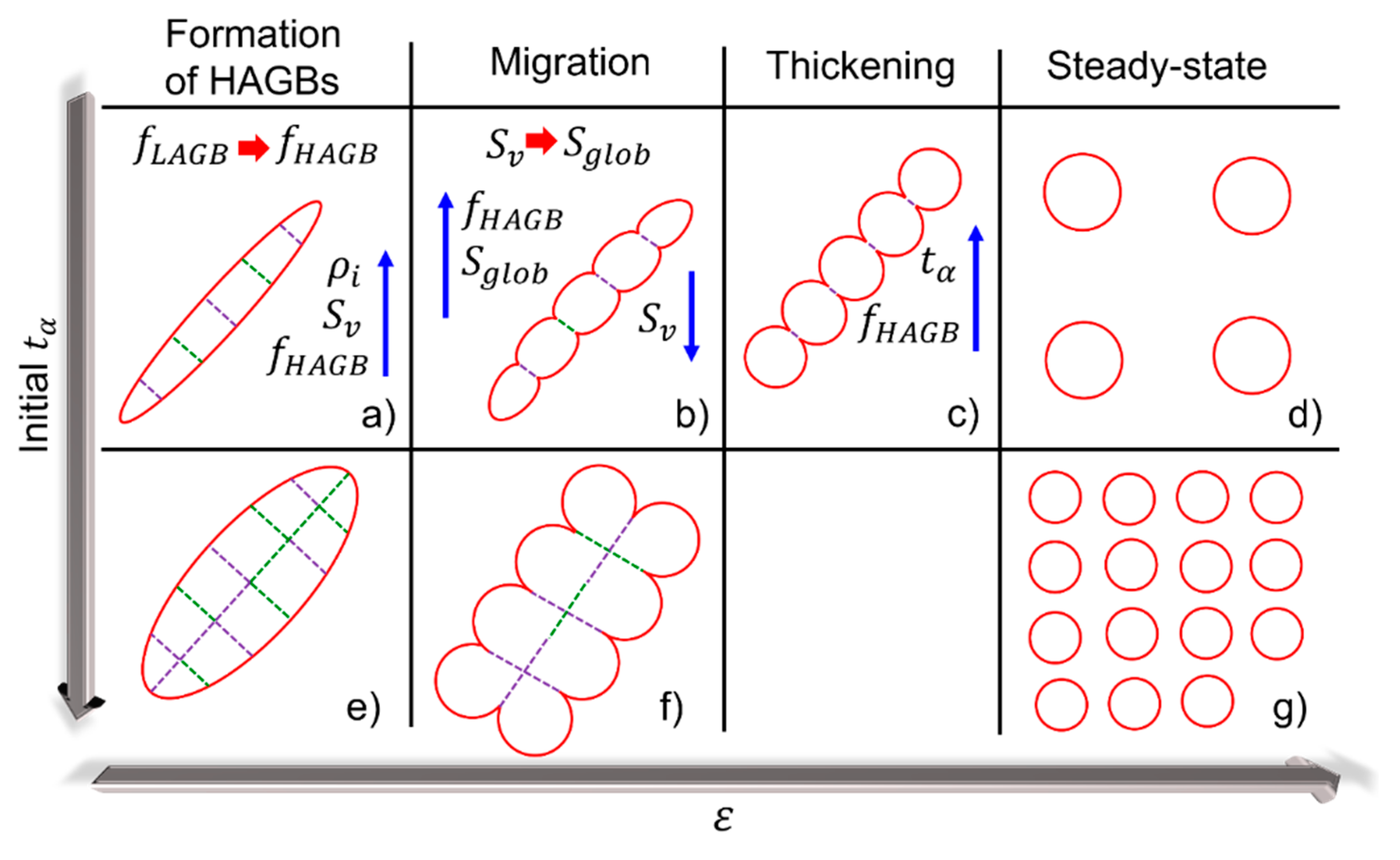
- Aspect ratio larger than one:
- Aspect ratio equals to one:
Appendix G
Appendix H
References
- Fan, X.G.; Zhang, Y.; Gao, P.F.; Lei, Z.N.; Zhan, M. Deformation behavior and microstructure evolution during hot working of a coarse-grained Ti-5Al-5Mo-5V-3Cr-1Zr titanium alloy in beta phase field. Mater. Sci. Eng. A 2017, 694, 24–32. [Google Scholar] [CrossRef]
- Chuan, W.; Liang, H. Hot deformation and dynamic recrystallization of a near-beta titanium alloy in the β single phase region. Vacuum 2018, 156, 384–401. [Google Scholar] [CrossRef]
- Qu, F.S.; Zhou, Y.H.; Zhang, L.Y.; Wang, Z.H.; Zhou, J. Research on hot deformation behavior of Ti–5Al–5Mo–5V–1Cr–1Fe alloy. Mater. Des. 2015, 69, 153–162. [Google Scholar] [CrossRef]
- Tan, K.; Li, J.; Guan, Z.; Yang, J.; Shu, J. The identification of dynamic recrystallization and constitutive modeling during hot deformation of Ti55511 titanium alloy. Mater. Des. 2015, 84, 204–211. [Google Scholar] [CrossRef]
- Poletti, C.; Germain, L.; Warchomicka, F.; Dikovits, M.; Mitsche, S. Unified description of the softening behavior of beta-metastable and alpha+beta titanium alloys during hot deformation. Mater. Sci. Eng. A 2016, 651, 280–290. [Google Scholar] [CrossRef]
- Warchomicka, F.; Poletti, C.; Stockinger, M. Study of the hot deformation behavior in Ti–5Al–5Mo–5V–3Cr–1Zr. Mater. Sci. Eng. A 2011, 528, 8277–8285. [Google Scholar] [CrossRef]
- Dikovits, M.; Poletti, C.; Warchomicka, F. Deformation Mechanisms in the Near-β Titanium Alloy Ti-55531. Metall. Mater. Trans. A 2014, 45, 1586–1596. [Google Scholar] [CrossRef]
- Matsumoto, H.; Kitamura, M.; Li, Y.; Koizumi, Y.; Chiba, A. Hot forging characteristic of Ti–5Al–5V–5Mo–3Cr alloy with single metastable β microstructure. Mater. Sci. Eng. A 2014, 611, 337–344. [Google Scholar] [CrossRef]
- Hiratani, M.; Zbib, H.M.; Khaleel, M.A. Modeling of thermally activated dislocation glide and plastic flow through local obstacles. Int. J. Plast. 2003, 19, 1271–1296. [Google Scholar] [CrossRef]
- Sun, Z.C.; Yang, H.; Han, G.J.; Fan, X.G. A numerical model based on internal-state-variable method for the microstructure evolution during hot-working process of TA15 titanium alloy. Mater. Sci. Eng. A 2010, 527, 3464–3471. [Google Scholar] [CrossRef]
- Peng, W.; Zeng, W.; Wang, Q.; Yu, H. Comparative study on constitutive relationship of as-cast Ti60 titanium alloy during hot deformation based on Arrhenius-type and artificial neural network models. Mater. Des. 2013, 51, 95–104. [Google Scholar] [CrossRef]
- Matsumoto, H.; Naito, D.; Miyoshi, K.; Yamanaka, K.; Chiba, A.; Yamabe-Mitarai, Y. Forging property, processing map, and mesoscale microstructural evolution modeling of a Ti-17 alloy with a lamellar (α+β) starting microstructure. Sci. Technol. Adv. Mater. 2017, 18, 893–904. [Google Scholar] [CrossRef] [PubMed] [Green Version]
- Kocks, U.F. A statistical theory of flow stress and work-hardening. Philos. Mag. 1966, 13, 541–566. [Google Scholar] [CrossRef]
- Bergström, Y. A dislocation model for the stress-strain behavior of polycrystalline α-Fe with special emphasis on the variation of the densities of mobile and immobile dislocations. Mater. Sci. Eng. 1970, 5, 193–200. [Google Scholar] [CrossRef]
- Bergstrom, Y.; Roberts, W. The dynamical strain ageing of α-iron: Effects of strain rate and nitrogen content in the jerky-flow region. Acta Metall. 1973, 21, 741–745. [Google Scholar] [CrossRef]
- Roberts, W.; Bergström, Y. The stress-strain behavior of single crystals and polycrystals of face-centered cubic metals-a new dislocation treatment. Acta Metall. 1973, 21, 457–469. [Google Scholar] [CrossRef]
- Mecking, H.; Estrin, Y. The effect of vacancy generation on plastic deformation. Scr. Metall. 1980, 14, 815–819. [Google Scholar] [CrossRef]
- Ghoniem, N.M.; Matthews, J.R.; Amodeo, R.J. Dislocation model for creep in engineering materials. Res. Mech. 1990, 29, 197–219. [Google Scholar]
- Buzolin, R.H.; Lasnik, M.; Krumphals, A.; Poletti, M.C. A dislocation-based model for the microstructure evolution and the flow stress of a Ti5553 alloy. Int. J. Plast. 2021, 136. [Google Scholar] [CrossRef]
- Buzolin, R.H.; Lasnik, M.; Krumphals, A.; Poletti, M.C. Hot deformation and dynamic α-globularization of a Ti-17 alloy: Consistent physical model. Mater. Des. 2021, 197, 109266. [Google Scholar] [CrossRef]
- Mecking, H.; Kocks, U.F. Kinetics of flow and strain-hardening. Acta Metall. 1981, 29, 1865–1875. [Google Scholar] [CrossRef]
- Gao, C.Y.; Zhang, L.C.; Yan, H.X. A new constitutive model for HCP metals. Mater. Sci. Eng. A 2011, 528, 4445–4452. [Google Scholar] [CrossRef]
- Nemat-Nasser, S.; Guo, W.G.; Cheng, J.Y. Mechanical properties and deformation mechanisms of a commercially pure titanium. Acta Mater. 1999, 47, 3705–3720. [Google Scholar] [CrossRef] [Green Version]
- Picu, R.C.; Majorell, A. Mechanical behavior of Ti–6Al–4V at high and moderate temperatures—Part II: Constitutive modeling. Mater. Sci. Eng. A 2002, 326, 306–316. [Google Scholar] [CrossRef]
- Ning, Y.Q.; Luo, X.; Liang, H.Q.; Guo, H.Z.; Zhang, J.L.; Tan, K. Competition between dynamic recovery and recrystallization during hot deformation for TC18 titanium alloy. Mater. Sci. Eng. A 2015, 635, 77–85. [Google Scholar] [CrossRef]
- Xiao, Y.-W.; Lin, Y.C.; Jiang, Y.-Q.; Zhang, X.-Y.; Pang, G.-D.; Wang, D.; Zhou, K.-C. A dislocation density-based model and processing maps of Ti-55511 alloy with bimodal microstructures during hot compression in α+β region. Mater. Sci. Eng. A 2020, 790, 139692. [Google Scholar] [CrossRef]
- Souza, P.M.; Beladi, H.; Singh, R.; Rolfe, B.; Hodgson, P.D. Constitutive analysis of hot deformation behavior of a Ti6Al4V alloy using physical based model. Mater. Sci. Eng. A 2015, 648, 265–273. [Google Scholar] [CrossRef]
- Fan, X.G.; Yang, H. Internal-state-variable based self-consistent constitutive modeling for hot working of two-phase titanium alloys coupling microstructure evolution. Int. J. Plast. 2011, 27, 1833–1852. [Google Scholar] [CrossRef]
- Babu, B.; Lindgren, L.-E.E. Dislocation density based model for plastic deformation and globularization of Ti-6Al-4V. Int. J. Plast. 2013, 50, 94–108. [Google Scholar] [CrossRef]
- Gao, P.F.; Guo, J.; Zhan, M.; Lei, Z.N.; Fu, M.W. Microstructure and damage based constitutive modelling of hot deformation of titanium alloys. J. Alloys Compd. 2020, 831, 154851. [Google Scholar] [CrossRef]
- Gao, P.; Yang, H.; Fan, X.; Zhu, S. Unified modeling of flow softening and globularization for hot working of two-phase titanium alloy with a lamellar colony microstructure. J. Alloys Compd. 2014, 600, 78–83. [Google Scholar] [CrossRef]
- OuYang, D.; Fu, M.W.; Lu, S.Q. Study on the dynamic recrystallization behavior of Ti-alloy Ti–10V–2Fe–3V in β processing via experiment and simulation. Mater. Sci. Eng. A 2014, 619, 26–34. [Google Scholar] [CrossRef]
- Chuan, W.; He, Y.; Wei, L.H. Modeling of discontinuous dynamic recrystallization of a near-α titanium alloy IMI834 during isothermal hot compression by combining a cellular automaton model with a crystal plasticity finite element method. Comput. Mater. Sci. 2013, 79, 944–959. [Google Scholar] [CrossRef]
- Ning, Y.Q.; Xie, B.C.; Liang, H.Q.; Li, H.; Yang, X.M.; Guo, H.Z. Dynamic softening behavior of TC18 titanium alloy during hot deformation. Mater. Des. 2015, 71, 68–77. [Google Scholar] [CrossRef]
- Liang, H.; Guo, H.; Ning, Y.; Peng, X.; Qin, C.; Shi, Z.; Nan, Y. Dynamic recrystallization behavior of Ti–5Al–5Mo–5V–1Cr–1Fe alloy. Mater. Des. 2014, 63, 798–804. [Google Scholar] [CrossRef]
- Bobbili, R.; Venkata Ramudu, B.; Madhu, V. A physically-based constitutive model for hot deformation of Ti-10-2-3 alloy. J. Alloys Compd. 2017, 696, 295–303. [Google Scholar] [CrossRef]
- Quan, G.; Luo, G.; Liang, J.; Wu, D.; Mao, A.; Liu, Q. Modelling for the dynamic recrystallization evolution of Ti–6Al–4V alloy in two-phase temperature range and a wide strain rate range. Comput. Mater. Sci. 2015, 97, 136–147. [Google Scholar] [CrossRef]
- Li, H.; Sun, X.; Yang, H. A three-dimensional cellular automata-crystal plasticity finite element model for predicting the multiscale interaction among heterogeneous deformation, DRX microstructural evolution and mechanical responses in titanium alloys. Int. J. Plast. 2016, 87, 154–180. [Google Scholar] [CrossRef]
- Sun, X.; Li, H.; Zhan, M. Full-stage prediction of discontinuous dynamic recrystallization of a titanium alloy through a sub-mesh internal state variables method. Model. Simul. Mater. Sci. Eng. 2019, 27, 015004. [Google Scholar] [CrossRef]
- Li, H.; Wu, C.; Yang, H. Crystal plasticity modeling of the dynamic recrystallization of two-phase titanium alloys during isothermal processing. Int. J. Plast. 2013, 51, 271–291. [Google Scholar] [CrossRef]
- Jones, N.G.; Dashwood, R.J.; Dye, D.; Jackson, M. Thermomechanical processing of Ti–5Al–5Mo–5V–3Cr. Mater. Sci. Eng. A 2008, 490, 369–377. [Google Scholar] [CrossRef]
- Jones, N.G.; Dashwood, R.J.; Dye, D.; Jackson, M. The Flow Behavior and Microstructural Evolution of Ti-5Al-5Mo-5V-3Cr during Subtransus Isothermal Forging. Metall. Mater. Trans. A 2009, 40, 1944–1954. [Google Scholar] [CrossRef]
- Khan, A.S.; Liang, R. Behaviors of three BCC metal over a wide range of strain rates and temperatures: Experiments and modeling. Int. J. Plast. 1999, 15, 1089–1109. [Google Scholar] [CrossRef]
- Goetz, R.L.; Semiatin, S.L. The adiabatic correction factor for deformation heating during the uniaxial compression test. J. Mater. Eng. Perform. 2001, 10, 710–717. [Google Scholar] [CrossRef]
- Song, B.; Dong, S.; Zhang, B.; Liao, H.; Coddet, C. Effects of processing parameters on microstructure and mechanical property of selective laser melted Ti6Al4V. Mater. Des. 2012, 35, 120–125. [Google Scholar] [CrossRef]
- Gourdet, S.; Montheillet, F. A model of continuous dynamic recrystallization. Acta Mater. 2003, 51, 2685–2699. [Google Scholar] [CrossRef]
- Shanthraj, P.; Zikry, M.A. Dislocation density evolution and interactions in crystalline materials. Acta Mater. 2011, 59, 7695–7702. [Google Scholar] [CrossRef]
- Hansen, B.L.; Beyerlein, I.J.; Bronkhorst, C.A.; Cerreta, E.K.; Dennis-Koller, D. A dislocation-based multi-rate single crystal plasticity model. Int. J. Plast. 2013, 44, 129–146. [Google Scholar] [CrossRef]
- Ma, A.; Roters, F.; Raabe, D. A dislocation density based constitutive model for crystal plasticity FEM including geometrically necessary dislocations. Acta Mater. 2006, 54, 2169–2179. [Google Scholar] [CrossRef]
- Mason, J.K.; Schuh, C.A. The generalized Mackenzie distribution: Disorientation angle distributions for arbitrary textures. Acta Mater. 2009, 57, 4186–4197. [Google Scholar] [CrossRef]
- Semiatin, S.; Bieler, T. The effect of alpha platelet thickness on plastic flow during hot working of TI–6Al–4V with a transformed microstructure. Acta Mater. 2001, 49, 3565–3573. [Google Scholar] [CrossRef]
- Mughrabi, H. The α-factor in the Taylor flow-stress law in monotonic, cyclic and quasi-stationary deformations: Dependence on slip mode, dislocation arrangement and density. Curr. Opin. Solid State Mater. Sci. 2016, 20, 411–420. [Google Scholar] [CrossRef]
- Taylor, G.I. Plastic strain in metals. J. Inst. Met. 1938, 62, 307–324. [Google Scholar]
- Sachs, G. Plasticity problems in metals. Trans. Faraday Soc. 1928, 24, 84–92. [Google Scholar] [CrossRef]
- Montheillet, F.; Damamme, G. Simple Flow Rules for Modeling the Behavior of Inhomogeneous Viscoplastic Materials. Adv. Eng. Mater. 2005, 7, 852–858. [Google Scholar] [CrossRef]
- Sun, J.-Z.; Li, M.-Q.; Li, H. Fragmentation of α Grains Accelerated by the Growth of β Phase in Ti–5Al–2Sn–2Zr–4Mo–4Cr during Hot Deformation. Adv. Eng. Mater. 2018, 20, 1700200. [Google Scholar] [CrossRef]
- Sun, J.Z.; Li, M.Q.; Li, H. Interaction effect between alpha and beta phases based on dynamic recrystallization of isothermally compressed Ti-5Al-2Sn-2Zr-4Mo-4Cr with basketweave microstructure. J. Alloys Compd. 2017, 692, 403–412. [Google Scholar] [CrossRef]
- Sonderegger, B.; Kozeschnik, E. Particle strengthening in fcc crystals with prolate and oblate precipitates. Scr. Mater. 2012, 66, 52–55. [Google Scholar] [CrossRef]
- Souza, P.M.; Beladi, H.; Singh, R.P.; Hodgson, P.D.; Rolfe, B. An Analysis on the Constitutive Models for Forging of Ti6Al4V Alloy Considering the Softening Behavior. J. Mater. Eng. Perform. 2018, 27, 3545–3558. [Google Scholar] [CrossRef]
- Semiatin, S.L.; Corbett, M.W.; Fagin, P.N.; Salishchev, G.A.; Lee, C.S. Dynamic-coarsening behavior of an α/β titanium alloy. Metall. Mater. Trans. A 2006, 37, 1125–1136. [Google Scholar] [CrossRef]
- Marsh, S.P.; Glicksman, M.E. Ostwald ripening in non-spherical morphologies. Mater. Sci. Eng. A 1997, 238, 140–147. [Google Scholar] [CrossRef]


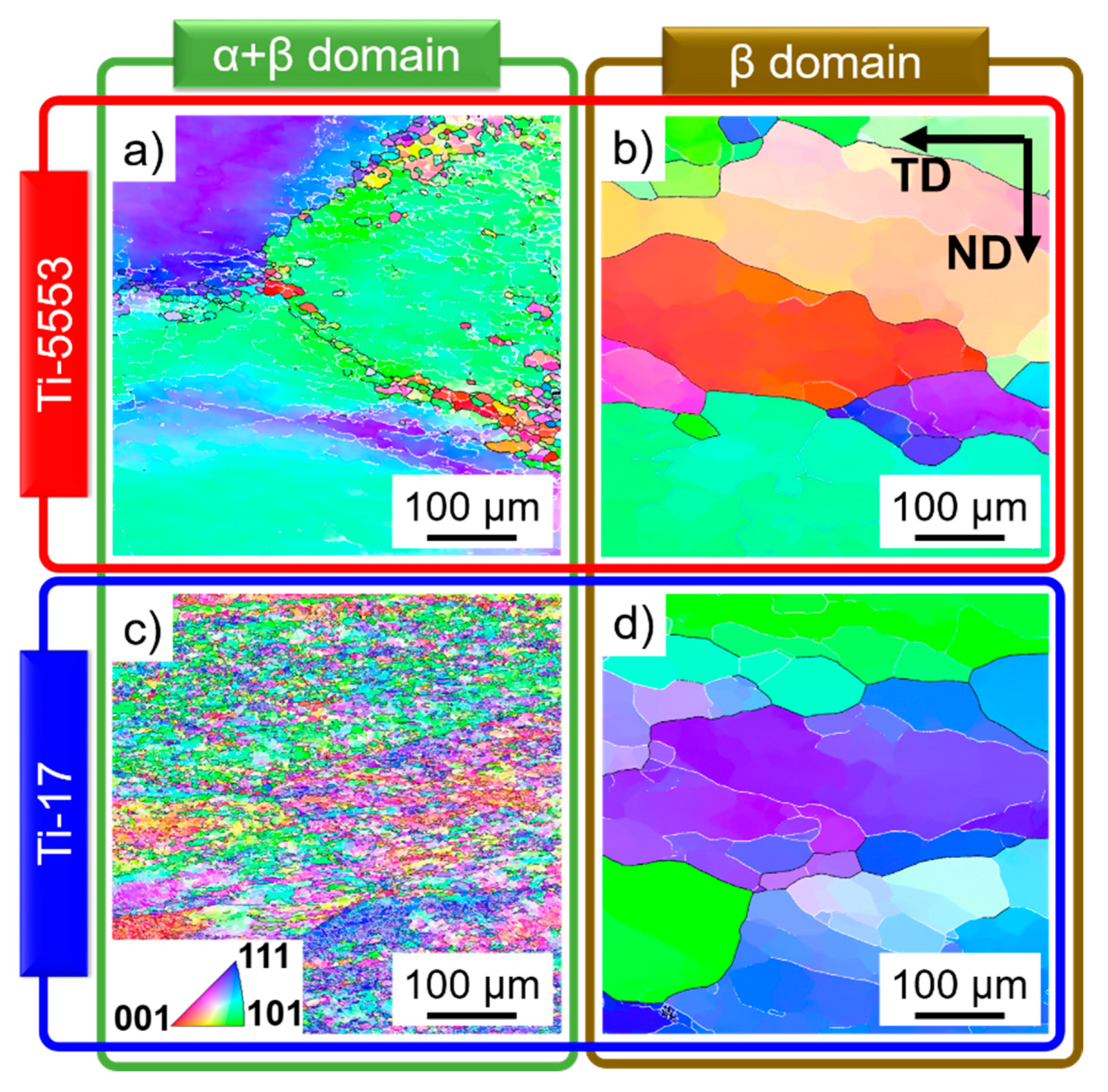



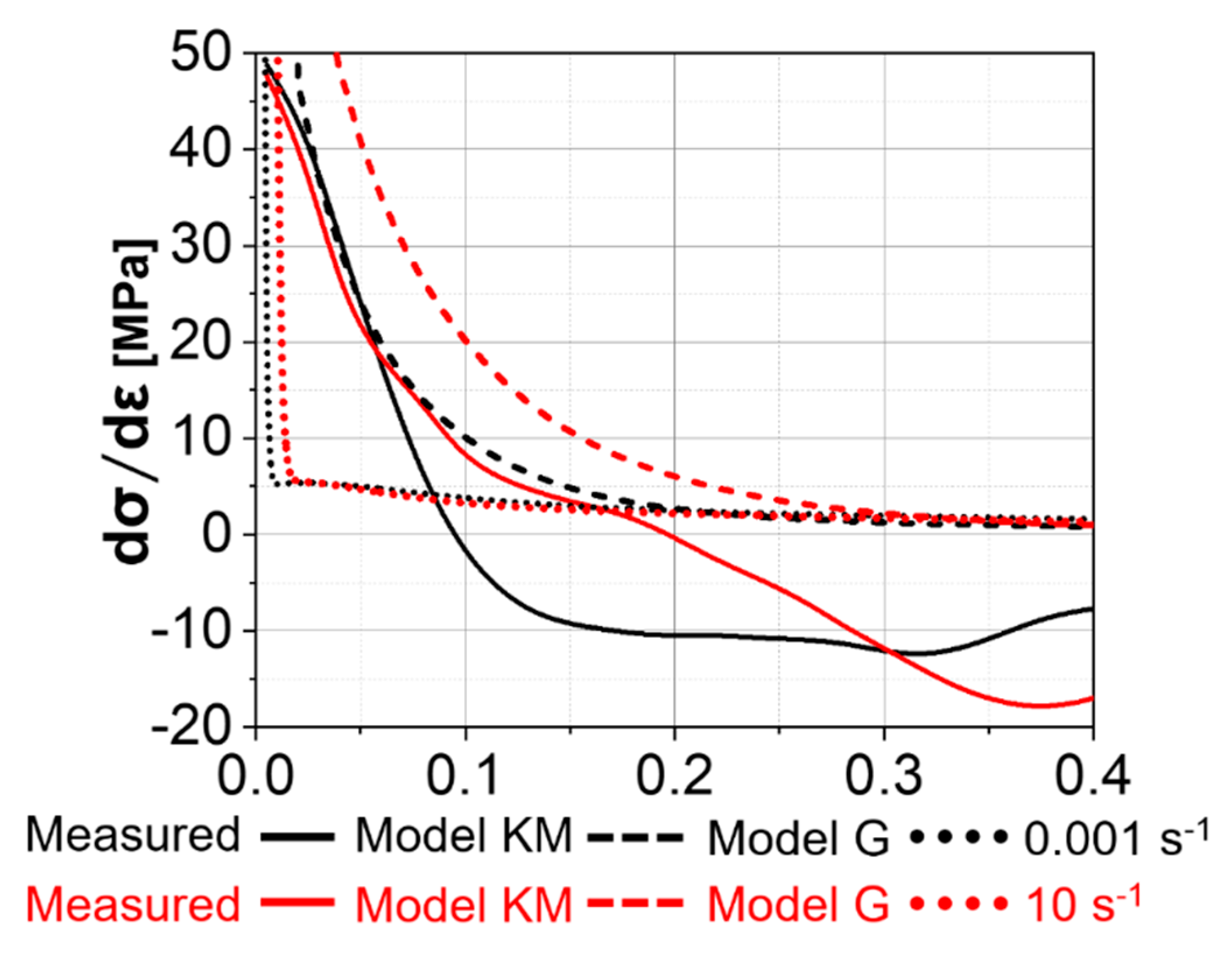
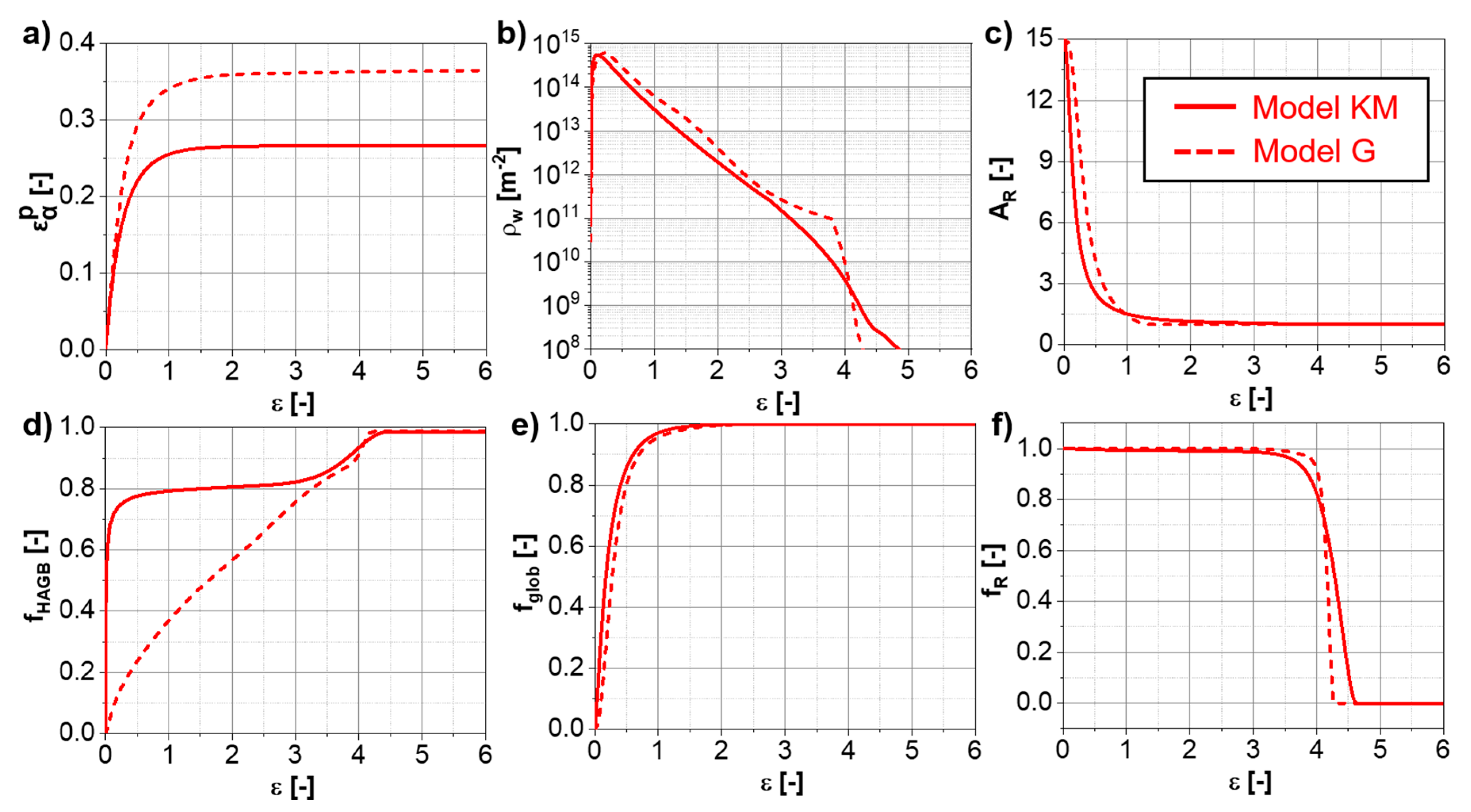




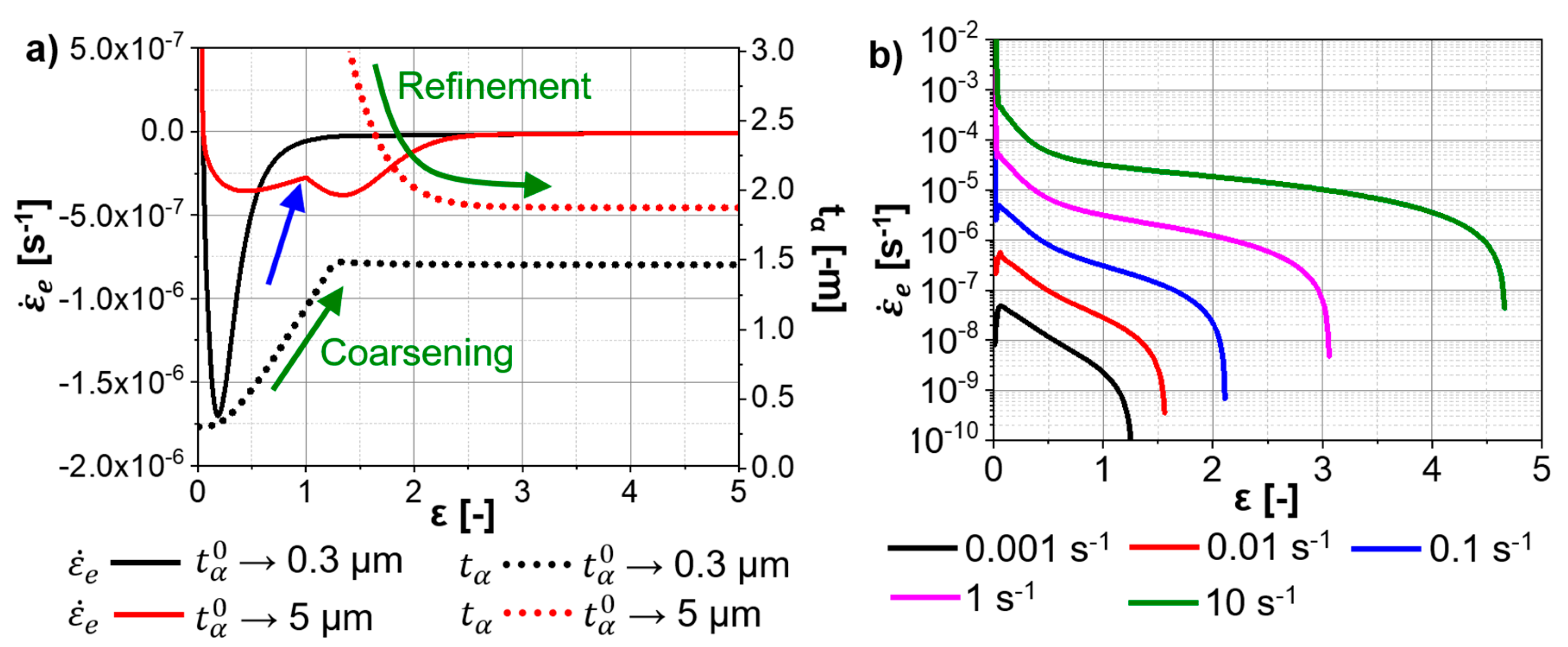


| Alloy | Al | V | Mo | Cr | Sn | Zr | Fe | O | N | C |
|---|---|---|---|---|---|---|---|---|---|---|
| Ti-5553 | 5.62 | 5.03 | 4.93 | 2.99 | - | - | 0.35 | 0.117 | 0.0094 | 0.0075 |
| Ti-17 | 4.96 | 0.01 | 3.91 | 3.68 | 1.95 | 1.91 | 0.08 | 0.112 | 0.05 | 0.05 |
Publisher’s Note: MDPI stays neutral with regard to jurisdictional claims in published maps and institutional affiliations. |
© 2020 by the authors. Licensee MDPI, Basel, Switzerland. This article is an open access article distributed under the terms and conditions of the Creative Commons Attribution (CC BY) license (http://creativecommons.org/licenses/by/4.0/).
Share and Cite
Buzolin, R.H.; Miller Branco Ferraz, F.; Lasnik, M.; Krumphals, A.; Poletti, M.C. Improved Predictability of Microstructure Evolution during Hot Deformation of Titanium Alloys. Materials 2020, 13, 5678. https://doi.org/10.3390/ma13245678
Buzolin RH, Miller Branco Ferraz F, Lasnik M, Krumphals A, Poletti MC. Improved Predictability of Microstructure Evolution during Hot Deformation of Titanium Alloys. Materials. 2020; 13(24):5678. https://doi.org/10.3390/ma13245678
Chicago/Turabian StyleBuzolin, Ricardo Henrique, Franz Miller Branco Ferraz, Michael Lasnik, Alfred Krumphals, and Maria Cecilia Poletti. 2020. "Improved Predictability of Microstructure Evolution during Hot Deformation of Titanium Alloys" Materials 13, no. 24: 5678. https://doi.org/10.3390/ma13245678
APA StyleBuzolin, R. H., Miller Branco Ferraz, F., Lasnik, M., Krumphals, A., & Poletti, M. C. (2020). Improved Predictability of Microstructure Evolution during Hot Deformation of Titanium Alloys. Materials, 13(24), 5678. https://doi.org/10.3390/ma13245678








